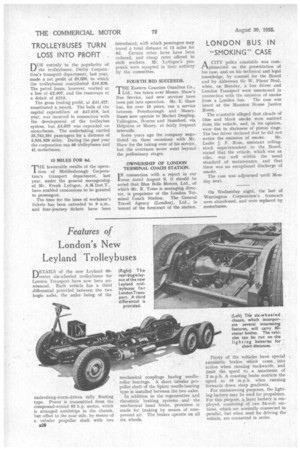Features of London's New Leyland Trolleybuses
Page 34

If you've noticed an error in this article please click here to report it so we can fix it.
DETAILS of the new Leyland 60seater six-wheeled trolleybuses for London Transport have now been announced. Each vehicle has a third differential provided between the two bogie axles, the axles being of the
underslung-worm-driven fully floating type. Power is transmitted from the compound-wound 82 h.p. motor, which is arranged amidships in the chassis, but offset to the near side, by means of a tubular propeller shaft with two
B28
mechanical couplings having needleroller bearings. A short tubular propeller shaft of the Spicer needle-bearing type is installed between the two axles.
In addition to the regenerative and rheostatic braking systems and the mechanical hand brake, provision is made for braking by means of compressed air. The brakes operate on all six wheels. Thirty of the vehicles have special automatic brakes which come into action when running backwards, and limit the speed to a maximum of 2 m.p.h. A coasting brake restricts the speed to 10 m.p.h. when running forwards down steep gradients.
For manceuvring purposes, the lighting battery may be used for propulsion. For this purpose, a layer battery is employed, consisting of two 24-volt sections, which are normally connected in parallel, but when used for driving the vehicle, are connected in series.












































































